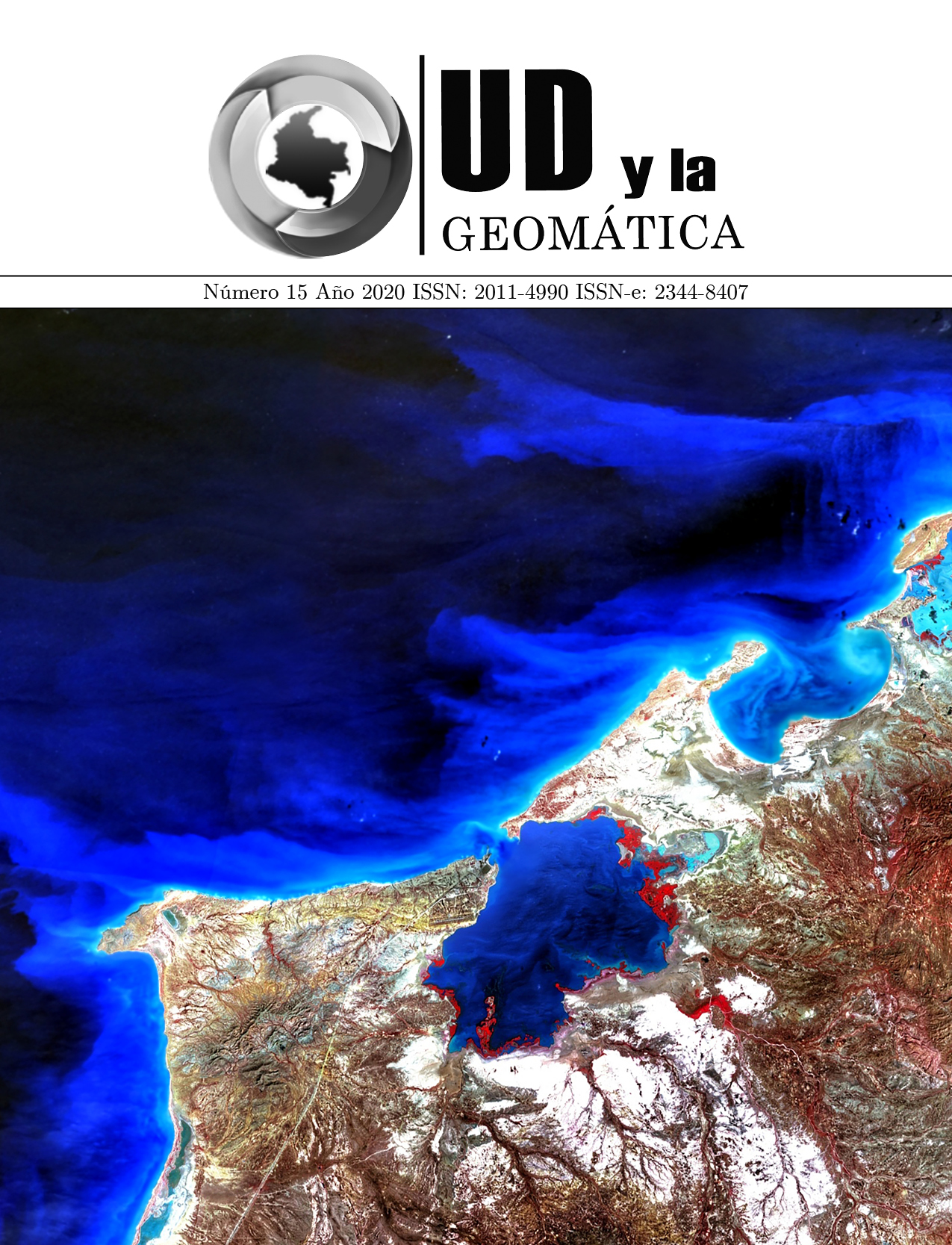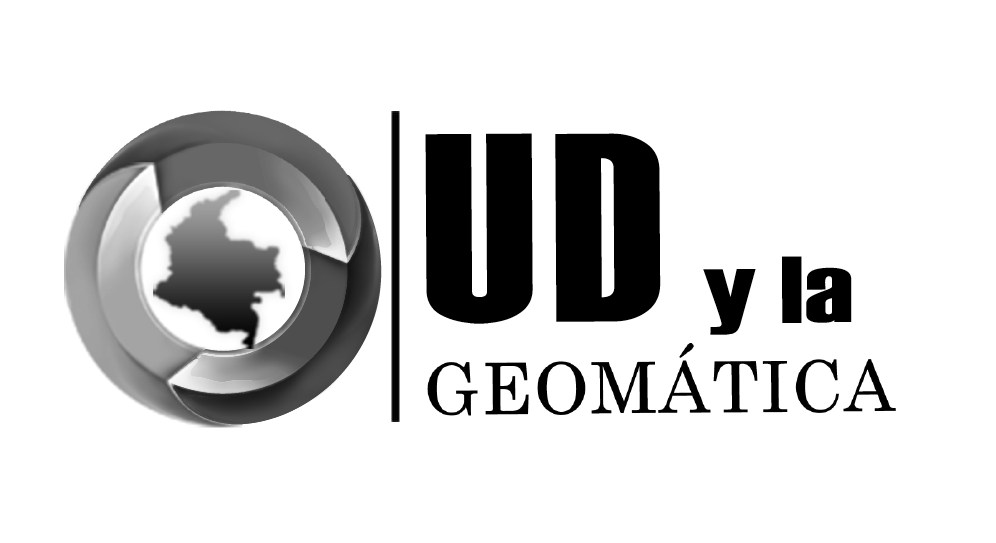DOI:
https://doi.org/10.14483/23448407.16309Published:
2020-09-10Issue:
No. 15 (2020)Section:
Artículo de revisiónFree network adjustment: Minimum inner constraints and Pseudo-inverse approaches
Ajuste de red libre: Enfoques de condiciones internas mínimas y pseudo inversa
Keywords:
Mínimos cuadrados, ajuste libre de redes, restricción mínima interna, Pseudo-inversa, Transformación S. (en).Keywords:
Least squares, Free adjustment networks, Minimum inner constrains, Pseudo-inverse, S- transformation. (es).Downloads
Abstract (en)
El método de los mínimos cuadrados es un procedimiento clásico para calcular las coordenadas de una red geodésica. Se pueden utilizar diferentes modelos para realizar el ajuste por mínimos cuadrados y así resolver el sistema linealizado que relaciona las observaciones (geometría interna) y el sistema de referencia (geometría externa). Uno de los métodos es el ajuste libre, el cual es un modelo que no utiliza coordenadas fijas en la matriz de diseño, por lo que la solución no tiene conexión con el sistema de referencia o datum. Por lo tanto, el problema de la deficiencia de rango o datum, que en términos de alegra lineal define una matriz singular para el sistema de ecuaciones normales que tiene que ser resuelto. Para ajustar una red geodésica mediante este método se utilizan principalmente dos enfoques de ajuste libre, la técnica de restricción mínima interna y la técnica pseudo inversa. Ambos modelos proporcionan resultados en un sistema de referencia arbitrario, por lo que la S-transformación es un procedimiento típico para transformar los resultados a un datum o sistema de referencia conocido. En este trabajo se presenta una revisión de ambos métodos y la metodología necesaria para realizar un ajuste de red libre. Finalmente se presentó un ejemplo para analizar la equivalencia entre ambos métodos. Los resultados obtenidos se compararon con una estimación realizada a través del modelo de ajuste injuncionado.
Abstract (es)
The least squares technique is a classic procedure to compute the coordinates of a geodetic network. Different approaches of this method have been development to perform the least squares adjustment and thus solve the linearized system that relates the observations (internal geometry) and the reference system (external geometry). The free adjustment is a model that not use fix coordinates in the design matrix, thus the solution does not have connection with referential system or datum. Therefore, the rank deficiency problem or datum defect, which in terms of linear algebra defines a singular matrix in the system of normal equations, must be solve. Two mainly approaches of free adjustment are used to solve a geodetic network, the minimum inner constraints and pseudo-inverse technique. Both models provide results in an arbitrary reference system, therefore, the S-transformation is a typical procedure to transform the result to a known datum. This paper presents a review of both methods and the methodology necessary to perform a free network adjustment. Finally, an example was presented to analyze the equivalence between both methods. The results obtained was compare with an estimation realize through the constrained adjustment.
References
Mikhail, E. M., & Ackermann, F. E. (1976). Observations and least squares. New York: IEP
Mikhail, E. M., & Gracie, G. (1981). Analysis and adjustment of survey measurements. New York: Van Nostrand Reinhold.
Teunissen, P. J. G. (2011). Adjustment theory: an introduction. (3a ed.). Delft: VSSD
Gemael, C.; Machado, A. M. I.; Wandresen, R. (2015) Introdução ao Ajustamento de Observações: Aplicações Geodésicas. 2. ed. Curitiba: UFPR.
Ghilani, C. D. (2018). Adjustment computations: Spatial data analysis. Hoboken, New Jersey: John Wiley & Sons, Inc.
Ogundare, J. O. (2019). Understanding least squares estimation and geomatics data analysis. Wiley
Mälzer, H., Schmitt, G. & Zippelt, Karl. (1979). Recent vertical movements and their determination in the Rhenish Massif. Developments in Geotectonics, 13, 167-176.
Blaha, G. (1982). A note on adjustment of free networks. Bulletin Géodésique, 56(4), 281–299.
Blaha, G. (1982a). Free networks: minimum norm solution as obtained by the inner adjustment constraint method. Bulletin Géodésique, 56(3), 209–219.
Papo, H.B. (1985) Extended free net adjustment constraints. Bulletin Geodesique, 59,378.
Even-Tzur, G. (2011). Deformation Analysis by Means of Extended Free Network Adjustment Constraints. Journal of Surveying Engineering, 137(2), 47–52.
Even-Tzur, G., & Shahar, L. (2015). Application of extended free net adjustment constraints in two-step analysis of deformation network. Acta Geodaetica et Geophysica, 51(2), 197–205
Even-Tzur, G. (2006). Datum definition and its influence on the reliability of geodetic networks. ZFV - Zeitschrift fur Geodasie, Geoinformation und Landmanagement. 131. 87-95.
Even-Tzur, G. (2010). Deformation Analysis by Means of Extended Free Network Adjustment Constraints. Journal of Surveying Engineering, 137(2).
Setan, H. & Singh, R. (2001). Deformation analysis of a geodetic monitoring network. Geomatica, 55.
Perelmuter, A. (1979) Adjustment of free networks. Bulletin Géodésique, 53,291.
Papo, H.B. & Perlmutter, A. (1981) Datum definition by free net adjustment. Bulletin Géodésique, 55, 218.
Teunissen, P. 1985. Zero Order Design: Generalized Inverses, Adjustment, the Datum Problem and S-Transformations. Optimization and Design of Geodetic Networks, 11-55.
Leick, A. (1982). Minimal constraints in two-dimensional networks. Journal of Surveying Engineering, 108, 53-68.
Rao, C.R. & Mitra, S.K. (1972). Generalized inverse of a matrix and its applications. (1 ed.).Theory of Statistics, University of California Press, Berkeley, California.
Mittermayer, E. (1972). A generalization of the least-squares method for the adjustment of free networks. Bulletin Geodesique, 104, 139.
Grafarend, E & Schaffrin, B. (1974) Unbiased free net adjustment. Survey Review, 22 (177), 200-218.
Meissl, P. (1982). Least squares adjustment: A modern approach. Graz, Austria: Geodätische Institute der Technischen Universität Graz.
Vanicek, P. & Wells, D. (1972). The Least Squares Approximation, UNB, Lecture Notes 22
Cross, P. A., & North East London Polytechnic. (1990). Advanced least squares applied to position fixing. London: North East London Polytechnic, Dept. of Land Surveying.
Krakiwsky, E.J. (1994): A Synthesis of Recent Advances in the Method of Least Squares, UNB, Lecture Notes 42
Vanicek, P. (1995): Introduction to Adjustment Calculus, UNB, Lecture Notes 35.
Strang, G., & Borre, K. (1997). Linear algebra, geodesy, and GPS. (2 ed). Wellesley: Wellesley-Cambridge Press.
Wells, D. & Krakiwsky, E.J. (1997): The method of Least Squares, UNB, Lecture Notes 18.
Camargo, P. O. (2000). Ajustamento de Observações. Presidente Prudente. Notas de Aula do Curso de Graduação em Engenharia Cartográfica. FCT/UNESP.
Nievergelt, Y. (2000). A tutorial history of least squares with applications to astronomy and geodesy. Journal of Computational and Applied Mathematics, 121(1-2), 37–72.
Aduol, F. (2003). Robust Geodetic Parameter Estimation Under Least Squares Through Weighting on the Basis of the Mean Square Error. Geodesy-The Challenge of the 3rd Millennium, 269-276.
Brinker, R. C., & Minnick, R. (2013). The surveying handbook. (2 ed). Springer.
Schaffrin, B., Snow, K. (2019). Notes on Adjustment Computations Part I Based on Former Geodetic Science Courses GS 650 and GS 651. The Ohio State University
Welsch, W. (1979). A review of the adjustment of free networks. Survey Review, 25,194, 167-180.
Caspary, W., Rueger, J. M. & University of New South Wales. School of Surveying (1987). Concepts of network and deformation analysis. School of Surveying, University of New South Wales, Kensington, N.S.W
Zeng, H., Yi, Q., & Wu, Y. (2015). Iterative approach of 3D datum transformation with a non-isotropic weight. Acta Geodaetica et Geophysica, 51(3), 557-570.
Deakin, R., (2005) Notes on Least Squares. School of Mathematical and Geospatial Science. RMIT
Teunissen, P. J. G. (2006). Network quality control. (1 ed).Delft: VSSD
Kuang, S. (1996). Geodetic network analysis and optimal design: concepts and applications. Ann Arbor Press, Chelsea Michigan
Shahar, L. & Even-Tzur, G. (2014). Improved analysis of vertical movements in the Carmel fault region, Israel, by extended free net adjustment. ZFV - Zeitschrift fur Geodasie, Geoinformation und Land management. 139. 115-124.
Snow, Kyle. (2002). Applications of Parameter Estimation and Hypothesis Testing to GPS Network Adjustments. Master of Science degree Thesis, The Ohio State University.
Koch K.R. (1985) First Order Design: Optimization of the Configuration of a Network by Introducing Small Position Changes. In: Grafarend E.W., Sansò F. Optimization and Design of Geodetic Networks. Springer, Berlin, Heidelberg.
Setan, H. (1995). S-transformations: A practical computational tool for deformation monitoring. Third Symposium on Surveillance and Monitoring Surveys Melbourne, Australia, 154-164.
Burdick, J. (2010). ME 115(a,b): Introduction to Kinematics and Robotics, Notes on the Moore-Penrose Pseudo-Inverse[Handouts]. Robotics. California Institute of Technology.
Acar, M., Ozludemir, M., Akyilmaz, O. & Celik, R. (2006). Deformation analysis with Total Least Squares. Natural Hazards and Earth System Science, 6 (4), 663-669.
Rossikopoulos, D., Fotiou, A., Pikridas, C., & Bitharis, S. (2016). Models and techniques in geodetic monitoring of tectonic deformations in Greece. Bulletin of the Geological Society of Greece, 50(3), 1570-1582.
Kotsakis, C. (2018). Datum Definition and Minimal Constraints. Encyclopedia of Geodesy, Springer Nature Switzerland.
Welsch, W. (1979). A review of the adjustment of free networks, Survey Review, 25:194, 167-180.
Baarda, W. (1981). S-transformations and criterion matrices. Delft, Netherlands: Rijkscommissie voor Geodesie.
Gründig, L., Neureither M., & Bahndorf J. (1985).Detection and Localization of Geometrical Movements. Journal of Surveying Engineering 111.2, 118–132.
Acar M., Ozludemir M. T., Erol S., Celik R. N., & Ayan T. (2008). Kinematic landslide monitoring with Kalman filtering. Natural Hazards Earth System Science, 8, 213–221.
Doganalp, S., Turgut, B. & Inal, C. (2010). Deformation analysis using the s transformation and kalman filtering technique. 10 th International Multidisciplinary Scientific Geo-Conference & EXPO SGEM 2010, Varna, Bulgaria.
Even-Tzur, G. (2012) Extended S-transformation as a tool for deformation analysis, Survey Review, 44:327, 315-318.
Erol, S., Erol, B., & Ayan, T. (2006.). Analyzing the Deformations of a Bridge Using GPS and Levelling Data. International Association of Geodesy Symposia Geodetic Deformation Monitoring From Geophysical to Engineering Roles, 244–253.
Guo, J., Zhou, M., Wang, C. & Mei, L. (2012). The application of the model of coordinate S-transformation for stability analysis of datum points in high-precision GPS deformation monitoring networks. Journal of Applied Geodesy, 6.
Schmitt, G (2013). Zero Order Design of Geodetic Networks. Curitiba, Brazil.
Granemann, D. (2005). Estabelecimento de uma rede geodésica para o monitoramento de estruturas: estudo de caso na usina hidrelétrica Salto Caxias [Establishing a Geodetic network for monitoring structures: a case study at Salto Caxias Dam] (Master dissertation). Federal University of Paraná, Curitiba, Brazil.
Tsutomu, S. (1984). ブリー平均の一考察 [On the Adjustment of Free Networks], Journal of the Geodetic Society of Japan, 30, 3, 175-197.
Nakane, K. (1990). フリー網平均における反復改良計算の問題 (数値計算例) [Problem of Iteration in Free-Network Adjustment (Numerical Example)], Journal of the Geodetic Society of Japan, 36, 3, 169-175.
Kotsakis, C. (2012). Reference frame stability and nonlinear distortion in minimum-constrained network adjustment, Journal of Geodesy, 86, 755–774.
Ipsen, I., Kelley, C. & Pope, S. (2011). Rank-deficient nonlinear least squares problems and subset selection. SIAM Journal on Numerical Analysis, 49:3, 1244-1266.
How to Cite
APA
ACM
ACS
ABNT
Chicago
Harvard
IEEE
MLA
Turabian
Vancouver
Download Citation
License
La revista UD y la Geomática se encuentra bajo una licencia Creative Commons - 2.5 Colombia License.
Atribución - No Comercial - Sin Derivadas





